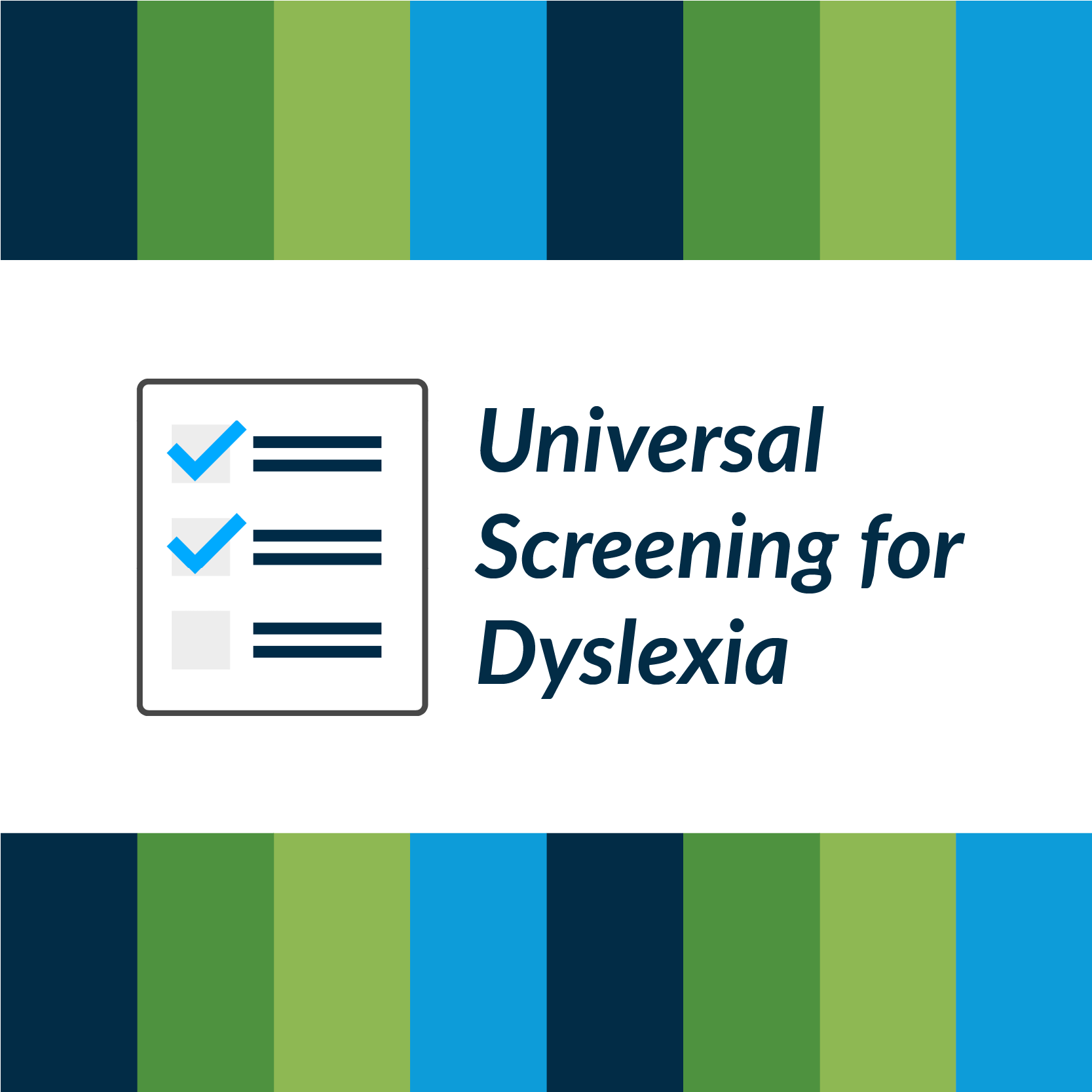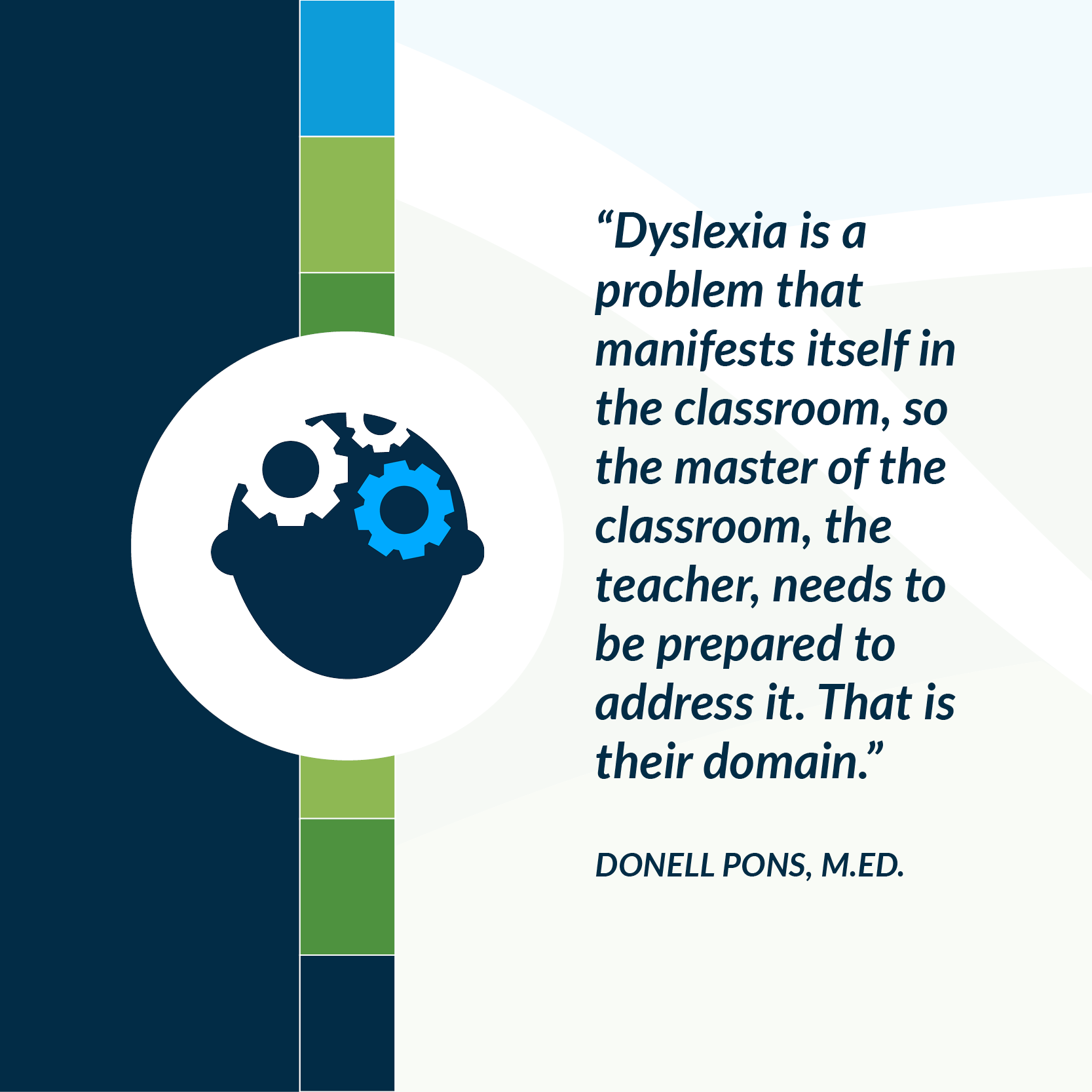In a recent panel discussion with dyslexia experts Donell Pons, M.Ed., and Shantell Berrett, M.A., the what, why, and how of universal screening for dyslexia were discussed in depth. Although it may be easy to recognize how this practice can help individual students, this interview also highlighted the benefits of early identification for entire schools.
What is universal screening for dyslexia?
 A universal screener for dyslexia is typically a list of items used to identify students who exhibit characteristics of dyslexia at the start of their education in order to provide appropriate instruction and targeted reading intervention. Screeners are typically more informal than an assessment and are used to obtain observations about language and literacy development by a child’s parents and teachers. Because most states do not allow schools to diagnose dyslexia, licensed professionals are generally needed for a formal diagnosis. Screeners simply help to identify indicators of dyslexia and/or general reading difficulties before students begin to experience significant educational consequences.
A universal screener for dyslexia is typically a list of items used to identify students who exhibit characteristics of dyslexia at the start of their education in order to provide appropriate instruction and targeted reading intervention. Screeners are typically more informal than an assessment and are used to obtain observations about language and literacy development by a child’s parents and teachers. Because most states do not allow schools to diagnose dyslexia, licensed professionals are generally needed for a formal diagnosis. Screeners simply help to identify indicators of dyslexia and/or general reading difficulties before students begin to experience significant educational consequences.
Universal screening for dyslexia is a growing practice, especially in states with legislation specific to addressing dyslexia in schools. With universal screening in place, schools can proactively address reading difficulties to improve the educational success of at-risk students.
What are the goals of universal screening for dyslexia?
Gather and respond to data about reading difficulties as early as possible
Schools have been collecting student data by reading assessments for decades. The problem is that often this data is not analyzed to look for the specific indicators of dyslexia and other reading difficulties. A screener can focus on specific indicators so that educators can appropriately address the needs of students, often by conducting a further assessment that will identify strengths and weaknesses in language and reading tasks.
Because reading is the most important skill in education, it is important that potential areas of difficulty are quickly identified and that intervention is available when a student is at risk for dyslexia. Research shows that when a child with dyslexia receives an early reading intervention that supports the development of neural pathways for reading, subsequent brain scans often appear similar to that of a good reader. The longer a student goes without receiving an intervention, the more likely that academic deficits become disabilities. This may also be true with related difficulties that can arise when a student continues to struggle with reading: school failure, poor self-esteem, and behavior problems are common examples.
Improve communication and get everyone on the same page
Communication changes when the specifics about a problem are known. In terms of screening for dyslexia, targeted information moves the conversation from wondering whether students are at risk for reading difficulties to quantifying how many students exhibit early characteristics. By implementing universal screening, schools no longer have to guess if they need to implement effective instruction and teacher training for addressing the needs of students with dyslexia, rather, they know the breadth of the need–and can justify the investment.
With screening in place, parent/teacher conversations about students that are struggling with reading can be more specific and centered around the nature of the problem. Without looking at specific indicators, it is difficult to discern whether a student is struggling because of dyslexia or other learning differences, attention problems, or behavioral patterns. When we misattribute the source of the difficulty, it becomes harder to solve; research-based indicators diffuse tension and emotion in conversations and look at the issue from an objective point of view.
Of course, we must also keep in mind what Reading Horizons Dyslexia Specialist, Shantell Berrett eloquently stated: “We need to be mindful of how to work together. We must approach a problem with a lot of understanding and grace, coming in from any other angle can make teachers/parents shut down towards each other instead of working together.”
Combining empathy with data and research to form the basis of conversations improves the quality of those conversations.
Bring reading improvement into focus school-wide and measure progress
Universal screening helps schools focus on the factors that enable reading progress. According to Pearson’s Law: “When performance is measured, performance improves. When performance is measured and reported back, the rate of improvement accelerates.”
If every school screens for reading difficulties at the start of the school year, we know which students to target, we have a baseline for measuring progress, and we know which students are making progress or not making progress.
What are the challenges and potential push back to universal screening for dyslexia?
There are several reasons that districts hesitate to implement a practice like universal screening for dyslexia.
It is difficult to meet the needs of students with dyslexia
Experts estimate that between 10-20% of all students have dyslexia so it won’t be uncommon that screening uncovers many students that are at-risk for reading difficulties. This can be overwhelming and many educators might begin to question the best way to meet the needs of so many students. It’s a big task to take on.
The Good News:
Every student benefits from the type of reading instruction that helps students with dyslexia learn to read. When schools implement a reading curriculum to meet the needs of students with dyslexia, every student receives more effective instruction. Decades of research have identified what students with dyslexia need: systematic, and sequential structured literacy. When schools provide instruction and intervention that match current research findings, they’ll be supporting the instructional needs of all students, including those with dyslexia.
Dyslexia isn’t a responsibility of schools and districts
Dyslexia is a hotly contested topic in many states and districts. Some refer to it as the “D-word” of education. It’s easy to defer the responsibility of addressing and remediating the reading problems of a student with dyslexia to parents, outside professionals, or lawmakers.
The Good News:
In the panel discussion referred to above, education and dyslexia specialist, Donell Pons, explained how dyslexia is a problem that is often only seen when a student enters the classroom. Outside of school or on tasks that do not involve reading, a student’s difficulties may not be readily apparent. These students often excel in creative, athletic, social, and problem-solving tasks. Thus, as Donell expertly put it: “Dyslexia is a problem that manifests itself in the classroom, so the master of the classroom, the teacher, needs to be prepared to address it. That is their domain.”

Fortunately, appropriate training and professional development for teachers are available to increase their knowledge base and support their instruction for students with dyslexia. The use of universal screening tools helps teachers become familiar with the indicators for dyslexia and to provide appropriate intervention when a student exhibits these characteristics.
Feels like one more initiative
Often school administrators have inherited schools where screening wasn’t in place or where other issues have taken priority. Schools are already trying to do so much that screening can easily feel like one more thing on a huge “To do” list. Educators often question when will there be enough time to do the screening.
The Good News:
In the early grades, foundational reading is the priority. Since reading is the thing that matters most in those early grades—time set aside for screening helps focus and monitor that priority. For older students, screening can pinpoint the reasons for literacy difficulties and better target intervention resulting in more effective use of time.
How to implement screening district-wide?
When implementing a district-wide system for screening for dyslexia, there are a few best practices to keep in mind:
- Make sure educators understand what the local state office of education is doing—what is currently mandated and why? What data is already being collected?
- Create a community in your district for screening so that everyone can learn from each other and share information rather than having multiple and separate “silos” of data and expertise.
- Paid screeners aren’t necessary. Screeners can’t help students get services—only a formal diagnosis can. Find appropriate and accessible tools for initial identification of risk factors.
- Set a cut point for intervention. Decide at what risk level students will receive intervention and how the results will link to the type of intervention to ensure that students have access to what they need.
- Create a plan for students that show risk factors but don’t yet meet the requirements for intervention—create a watch plan so these students don’t fall between the cracks.
- Train teachers to recognize the risk factors and prepare them with appropriate interventions.
How can we prepare teachers to screen for dyslexia?
When it comes to dyslexia, there is a great deal of research on specific indicators and interventions. The biggest obstacle to improvement has been getting this research into the hands of teachers. That is why it is important to work together and share experience and expertise, and of course, train teachers to recognize the common indicators of dyslexia and other reading difficulties.
Common Indicators:
In a family with a history of dyslexia, students can be identified early—as soon as they start to speak.
Some pre-reading indicators:
- late speech onset, prolonged baby talk
- a family history of reading or learning difficulties
- Difficulty recognizing or producing rhymes
- mixing up sounds (ow-me instead of meow as an animal sound for example)
Common indicators for 6/7-year-olds:
- difficulty learning or retaining letter names and sounds
- recognizing a word on one page and not recognizing it a short time later
- guessing at or skipping words
- very slow or choppy reading
- avoiding reading
- anxiety about reading/school
- behavior problems (i.e. class clown, shut down during reading activities)
Additional indicators for older students:
- strengths that aren’t connected to print, excelling in areas outside of reading
- adequate verbal language skills but difficulty learning, recognizing, or sounding out simple words when reading
- difficulty sounding out new and unfamiliar words (i.e., difficulty with phonics/word level decoding)
- letter reversals (example: b/d, p/q), and reading or writing transpositions (Example: girl for grill)
- spelling difficulties, particularly omitting blocks of sound or the order of sounds in words
- comprehension that improves when something is read to them as compared to a text they read themselves
- adequate math skills, but difficulty with math word problems
- difficulties with reading that weren’t apparent in earlier grades. Students with good visual memory often won’t appear that they’re behind for a long time.
How can we help students once they’ve been identified as being at risk for/having dyslexia?
Screening is just the first step in addressing the needs of students with dyslexia and other reading challenges. If anything, screening simply justifies the need for a solid, research-based reading curriculum that addresses the needs of students with dyslexia and supports literacy acquisition for all students.
In addition to implementing universal screening for every K-3 student, it is crucial that teacher training is available to prepare every teacher to address the needs of this student population in the classroom. Once we know that students are at-risk for reading difficulty, we must ensure that teachers have the knowledge and resources to provide appropriate intervention.
Phonics-based reading instruction has been found to be the most effective for students with dyslexia, but, as Reading Horizons Dyslexia Specialist Shantell Berrett warns: “Not all phonics instruction is created equal.” Phonics in and of itself is not effective for dyslexia—specific types of phonics instruction as outlined by the National Reading Panel have been shown to better support reading achievement for these students.
In addition to preparing teachers to provide effective reading instruction for students with dyslexia, it is also crucial that teachers and parents focus on the strengths of students with dyslexia or other reading difficulties. When a student’s school experience is primarily negative—struggling and avoidance—they frequently dislike school. If, however, they have opportunities to excel in other areas that embrace their strengths, positive associations with school can be created.
It is also important that teachers allow students to express what they know in a variety of different ways so that each student can demonstrate their knowledge and abilities. Reading is an important skill, but it does not define a student or their inherent worth. These students need opportunities to learn and reach their full potential.
Resources
Kilpatrick, Essentials of Assessing, Preventing, and Overcoming Reading Difficulties
Shaywitz, Overcoming Dyslexia
